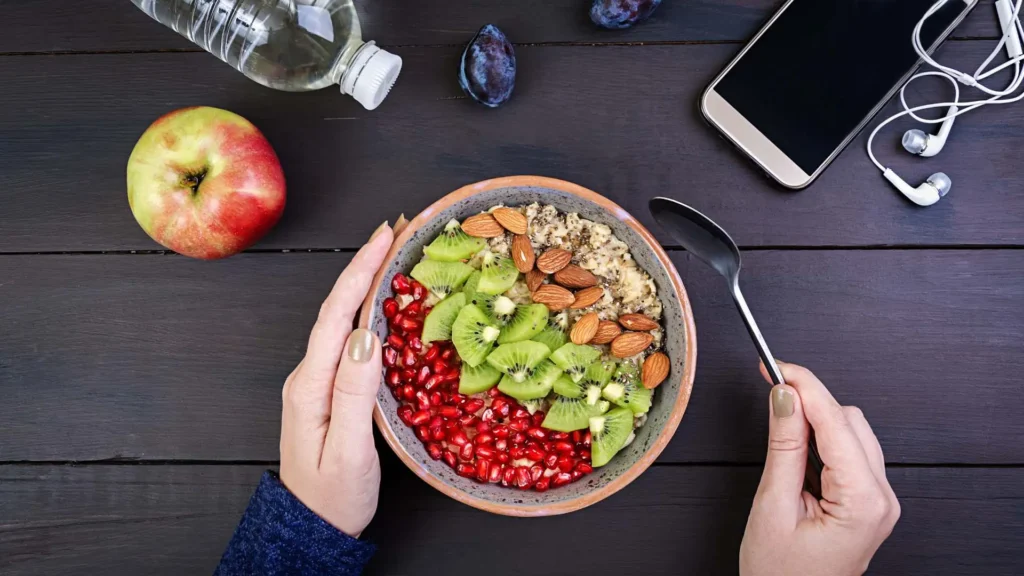Eating healthy keeps you fit and happy. However, it may seem costly, primarily when balancing school, work, and a limited amount of money. But guess what? You don’t need to break the bank to eat well.
With the right strategies in place, you can get all the nutrients you need. From savvy grocery shopping to using short and simple meal prep, there are many ways to eat healthier for less. You may need to seek cheaper proteins, low-priced fresh fruits and vegetables, and simple recipes that don’t take much time.
This guide will help you plan meals for healthy eating. You’ll find tips on where to get healthy food on a budget and know how to make low-cost, nutritious meals.
And when you need a quick financial boost, tools like Blitz have your back — giving you early access to your verified bank deposits between $9–$99 in just 99 seconds, all for 99¢/month.
Get ready to eat better, feel better and save, all at once. So, let’s explore tips to make your money go further and keep you focused!
Read: Student Life on a Budget: Your Ultimate Guide to Thriving Without Breaking the Bank
Why Healthy Eating Matters for Students
Attending classes, assignments, and a social life requires a lot of energy. The right nutrition allows for clear focus, intense study periods, and no afternoon crashes. Healthy eating is not only beauty care but also feeling good, being healthy, and getting through college without burnout.
Increases Productivity
Healthy eating promotes attention and memory development. Foods such as eggs, nuts, and greens are brain food. Cheap, healthy food options are essential during the exam period and last-minute cramming for finals.
Increases Energy Levels
Processed junk food causes energy crashes. Whole foods help maintain steady power. Candy, soda, chips, and other processed sugary foods will zap your energy. Say goodbye to feeling tired in the middle of the day, and instead, hello to more active, productive days.
Improves Mood and Reduces Stress
Your mood is a function of what you eat. A whole-food diet lowers stress and anxiety, stabilizing your mood. Eating well this way involves meal plans that include beneficial foods such as fish, nuts, and delicious dark chocolate, which can greatly improve your fitness level.
Strengthens the Immune System
Busy schedules and a lack of sleep can weaken one’s immune system, but always remember that a balanced diet keeps you strong. Citrus fruits, garlic, and yogurt may be cheap but these foods help fend off colds and infections.
Helps Maintain a Healthy Weight
Fast food is convenient, but it contains unhealthy fats and sugars. Preparing dishes with lean proteins, whole grains, and vegetables also helps you maintain a healthy weight without extra cost.
Builds Healthy Habits for Life
The habits you develop in college stay with you. Learning to prepare simple, affordable meals now is a way to establish a pattern of good nutrition after graduation. Low-cost nutrition is not only for today; it’s for a healthy tomorrow.
Supports Better Sleep
Caffeine and sugar can mess with your sleep. A balanced diet with proteins, healthy fats, and complex carbs helps good quality sleep. Good rest means good concentration, memory, and more energy to subject you to your college life.
Read: How to Save Money on Coffee and Snacks
Top Budget-Friendly Healthy Foods
Healthy eating doesn’t need to break the bank. A lot of inexpensive foods can sustain you and keep you going. Here are some healthy foods:
Oats
Oats are an excellent option for breakfast or snacks. For a nutritious, inexpensive meal, top it with fruit, nuts, or peanut butter.
Beans & Lentils
Cheap, high in protein, and a cinch to cook. Toss them into soups, salads, or burritos for a healthy filling option.
Rice & Whole Grains
Brown rice, quinoa, or whole wheat pasta are cheap meal bases. They keep you full longer and fit into many dishes.
Canned Tuna or Chicken
Another protein-rich option is canned chicken or tuna, which is budget-friendly and has a long shelf life. Mix it with whole wheat pasta and salad for a quick, affordable meal.
Read Related Blog: How to Save Money on Food Delivery Apps Without Giving Up Convenience?
Meal Planning Tips for Students
Everyone knows that meal planning makes life easier. Instead of scrambling for last-minute dinners or spending money on takeout, you’ll always have a plan. It saves you time, encourages you to eat positively, and keeps you on budget. Here’s how to do it right.
Plan Your Meals for the Week
Pick a few simple things to eat and stick to them. This will save you from last-minute food runs and impulse buying. Budget-friendly meals include stir-fries, sandwiches, and pasta, which are low-cost to prepare. Planning also means you have healthy foods available.
Make a Grocery List
Make yourself a list of what you need before you go to the store. Staying on a list avoids those extra snacks and keeps you to the cheap, healthy foods. A good grocery list helps you save money and prevents impulse buys.
Use Leftovers Wisely
Be creative and try not to throw food away. Use last night’s chicken for a sandwich, and add leftover roasted veggies to your omelet. By stretching ingredients, you will buy less frequently, allowing you to maximize the purchase of purchased products.
Stick to Simple Recipes
Complicated dishes require too many ingredients and take a lot of time. To avoid hassle, stick to easy dishes, such as stir-fries, wraps, or salads. Always remember, cooking should be stress-free to keep you on budget.
Be Flexible but Smart
It’s alright to have a meal plan, but it can be flexible too. Try creative meal adjustments, like changing meals to swap for cheaper ingredients.

How to Shop Smart for Healthy Groceries
With good planning, you can maintain a healthy lifestyle on a budget. Here are some tips for saving money at the grocery store while keeping your nutrition intact.
Buy in Bulk
Staples like rice beans, pasta, and oats are more affordable when bought in bulk. This reduces the per-serving cost and ensures that essential ingredients are available. Try to find discount or wholesale stores that can help you buy in bulk to reduce expenses.
Shop Store Brands
Generic or store-brand products are often similar in quality to name brands but cost less. Using store-label products instead of name brands for cereal, dairy, and canned goods can help save money without compromising quality or taste.
Use Coupons and Discounts
Multiple grocery retailers implement special offers to reward loyal customers. Store apps and online platforms often contain student-friendly discounts on nutrition essentials. Taking a minute or two to search for coupons can be beneficial in the long run and does not hurt.
Stick to the Perimeter
The outer aisles usually contain fresh produce, dairy, and lean proteins. The middle aisles often have processed and expensive foods. Shopping smart starts with choosing whole, unprocessed foods for better nutrition and value.
Plan Your Grocery List
Unplanned shopping can lead to unnecessary spending. Make a list based on your weekly meal planning and stick to it. This will enable you to purchase only those items necessary while keeping expenses away.
Read: The Student’s Guide to Finding the Best Deals
Quick and Easy Healthy Recipes for Students
Eating healthy is simple. These fast recipes are perfect for busy students. They are quick, tasty, and inexpensive. You could do this with a handful of ingredients, and it takes minutes.
Overnight Oats
Combine oats, milk (or yogurt), and fruit in a jar. Refrigerate overnight, and breakfast is set for the morning. For added flavor and nutrients, stir in honey, peanut butter, or nuts. It’s a no-cook meal that fills you up for hours.
Budget-Friendly Stir-Fry
Sauté fresh or frozen vegetables with chicken, tofu, or beans. Season with soy sauce or spices, and serve over rice or noodles. This easy meal is nutritious and budget-friendly. Personalize it with whatever you have at that very moment.
Egg & Avocado Toast
Smash avocado on whole wheat toast, place a fried or boiled egg on top, and sprinkle with salt and pepper. This quick protein-dense meal comes together in minutes. Throw in some tomatoes or spinach for extra health.
DIY Burrito Bowls
For a homemade burrito bowl, layer cooked rice, beans, a protein source, salsa, and shredded cheese. It’s an inexpensive alternative to takeout and delicious in its own right. You can also add veggies, guacamole, or hot sauce.
Greek Yogurt Parfait
In a cup, layer Greek yogurt, granola, and fresh or frozen fruit. It is a budget-friendly high-protein snack or breakfast. For flavor, drizzle with honey or sprinkle with nuts. It’s fast, healthy, and great for grab-and-go.
Quick Veggie Omelet
Combine a few eggs in a bowl and pour them out in a pan. Then add any vegetables you have, peppers, onions, and spinach work well. Make sure to cook until they are firm before serving. A side of whole wheat bread also works nicely. High in protein this dish works for any time of the day.
Key Takeaways & Next Steps
Believe it or not, eating healthy on a budget is doable. With clever meal planning, inexpensive groceries, and easy recipes, you can nourish your body without breaking the bank. Small changes like cooking your meals and preparing meals several days in advance can help improve your health and also save money.
Blitz is here for those times when you need a bit more financial support. It’s super easy to handle those unexpected expenses with instant cash advances of $99. No interest, no credit checks. t’s a simple, stress-free way to stay afloat during tight times. Download the app here.
Start today! Pick up healthy staples, plan your meals, and take control of your nutrition. Make smart, small decisions now and come out the other side with a healthy and affordable lifestyle.




